建筑能源合理化使用项目
Timeline
Based on the Seoul Energy Declaration of April, 2007, Seoul established a goal of reducing 15% of energy consumption and 25% of greenhouse gas emissions by 2020 compared to figures from 1990. As of June, 2009, Seoul is carrying out such reinforced energy saving policies so as to reduce 20% of energy consumption and 40% of greenhouse gas emissions by 2030 in comparison to the 1990 figures. One of the more important energy consumption reduction policies is the Building Retrofit Program (BRP). The BRP was initiated as a result of the C 40 Mayors Summit held in New York in May, 2007. BRP was introduced to materialize and implement the agreed BRP in the public sector. BRP is a financing program for the private and public sectors to reduce greenhouse gas by finding high energy loss factors of energy-consuming buildings and to modify the insulation, lighting, roof, and windows and thus save energy and maximize the overall efficiency.
Early BRP mostly focused on the existing public buildings of Seoul City Government. For the BRP in the public sector, Seoul analyzed the building, mechanical, and electric energy of 34 affiliated public agency buildings with an annual 300 Total of Oil Equivalent (TOE) or more energy consumption from October to December, 2007. From these models it then considered various improvement solutions. Based on the analysis results, Seoul started remodeling a pilot project in March, 2008 to reduce energy consumption and improve the efficiency of the public agencies.
As climate change response became an increasingly important political issue, Seoul established and executed the Comprehensive Measures for One Less Nuclear Power Plant Initiative in 2012 to preemptively respond to the problem of climate change by reducing energy demands and extending renewable energy production. Accordingly, the BRP was extended as one the most important policies of the Comprehensive Measures for One Less Nuclear Power Plant Initiative on the basis of existing policies. In 2012, Seoul also included all types of buildings – from existing building to housing (including detached ones to aged apartments) – in the BRP for the first time in Korea. For the energy welfare through energy saving, it was extended to all types of buildings, including the housing of the low-income class. More specifically, Seoul implemented the BRP for 761 large and medium energy-guzzling buildings and 10,000 detached houses to innovatively improve the overall energy efficiency of buildings that were consuming 58% of all energy consumption in Seoul and provided on-site energy analysis & consulting for small houses and buildings. It also tried to improve the energy efficiency of 51,000 public rental households and 59 social welfare facilities. Finally, it had 30 universities developed as low-carbon green campuses to improve the energy efficiency of all types of buildings.
The BRP has been viewed positively as a key facet of the Comprehensive Measures for One Less Nuclear Power Plant Initiative thus far in contributing to considerably reduced energy consumption and thus greenhouse gas emission of buildings that were consuming a large portion of energy in Seoul.
Early BRP mostly focused on the existing public buildings of Seoul City Government. For the BRP in the public sector, Seoul analyzed the building, mechanical, and electric energy of 34 affiliated public agency buildings with an annual 300 Total of Oil Equivalent (TOE) or more energy consumption from October to December, 2007. From these models it then considered various improvement solutions. Based on the analysis results, Seoul started remodeling a pilot project in March, 2008 to reduce energy consumption and improve the efficiency of the public agencies.
As climate change response became an increasingly important political issue, Seoul established and executed the Comprehensive Measures for One Less Nuclear Power Plant Initiative in 2012 to preemptively respond to the problem of climate change by reducing energy demands and extending renewable energy production. Accordingly, the BRP was extended as one the most important policies of the Comprehensive Measures for One Less Nuclear Power Plant Initiative on the basis of existing policies. In 2012, Seoul also included all types of buildings – from existing building to housing (including detached ones to aged apartments) – in the BRP for the first time in Korea. For the energy welfare through energy saving, it was extended to all types of buildings, including the housing of the low-income class. More specifically, Seoul implemented the BRP for 761 large and medium energy-guzzling buildings and 10,000 detached houses to innovatively improve the overall energy efficiency of buildings that were consuming 58% of all energy consumption in Seoul and provided on-site energy analysis & consulting for small houses and buildings. It also tried to improve the energy efficiency of 51,000 public rental households and 59 social welfare facilities. Finally, it had 30 universities developed as low-carbon green campuses to improve the energy efficiency of all types of buildings.
The BRP has been viewed positively as a key facet of the Comprehensive Measures for One Less Nuclear Power Plant Initiative thus far in contributing to considerably reduced energy consumption and thus greenhouse gas emission of buildings that were consuming a large portion of energy in Seoul.
Background Information
In the 2000s, many countries started to recognize the global challenges of energy efficiency, renewable energy, and greenhouse gas reduction through the G8 and APEC summits. The United Nations Framework Convention on Climate Change and the Kyoto Protocol demanded the reduction of greenhouse gas. Seoul also faced the important challenges of reducing energy consumption and thus greenhouse gases. In particular, Seoul was accountable for 10.9% (49,565GWh) of nation-wide power consumption as of 2011 but its energy self-sufficiency rate was only 2.8% - making it vulnerable to energy security. Seoul was faced with gradually increased energy consumption and so required energy crisis measures for unstable energy supply and others associated problems.
 Figure 1. Trend of increasing energy and power consumption in Seoul (Source: Introduction of One Less Nuclear Power Plant Policy (2012), Seoul City Government)
Figure 1. Trend of increasing energy and power consumption in Seoul (Source: Introduction of One Less Nuclear Power Plant Policy (2012), Seoul City Government)
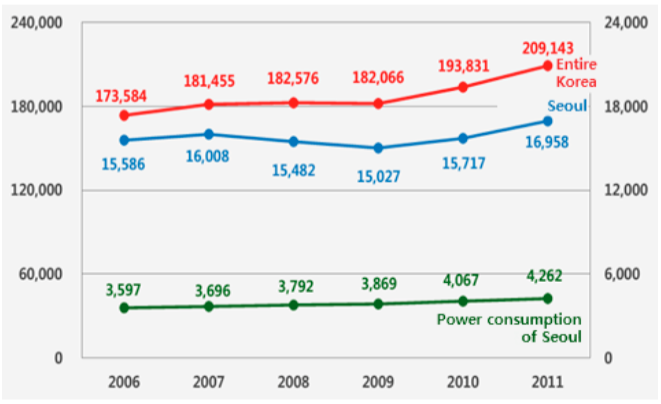
As most responsible for energy consumption and carbon emission in Seoul, energy consumption in buildings was the most important target of Seoul’s energy measures. Seoul had been reinforcing design criteria and introducing different green building policies but energy consumption in residential and commercial building was exceeding 50% of the entire energy consumption in Seoul every year. Moreover, the improved financial state of citizens and the increased number of buildings drove a continuous increase in energy consumption in building and thus it became urgent to establish energy policies for these buildings.

Figure 2. Seoul energy consumption by sector and source
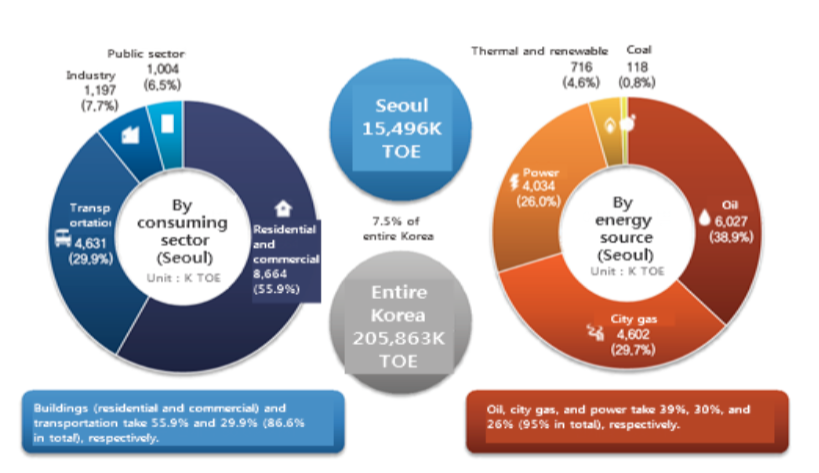
(Source: Introduction of One Less Nuclear Power Plant Policy (2012), Seoul City Government)
Seoul, therefore, introduced different new energy saving policies for building. They included the following methods designed to tackle the growing problem: building energy saving criteria for new buildings, building energy efficiency ratings, housing performance rating labeling, and eco-friendly building certifications. Now, construction permission is not given to new buildings that do not fulfill the Evaluation Criteria of Construction Committee, Seoul and Total Energy Consumption Criteria of Building. However, while the energy saving policies for building are targeting mostly new buildings, policies on existing buildings were not enough . Criteria and guidelines for old buildings have not been established and there was not enough consultation on the analysis and efficient energy saving of old buildings – it was instead dependent on the voluntary participation of the private sector. Indeed, 73% of buildings had been built before the insulation criteria were reinforced (2001) as of 2008. Therefore, it was impossible to save energy consumed in buildings efficiently with the participation of only new building without enhancing the energy efficiency of old ones. To this end, BRP was introduced in Seoul to improve the energy efficiency of old buildings.
Table 1. State of aged buildings as of 2008
| Classification | Completed construction before 1980 | Completed construction between 1981-2001 (accumulated) | Total as of 2008 (accumulated) | |||
| Architectural area (K m²) |
Ratio (%) |
Architectural area (K m²) |
Ratio (%) |
Architectural area (K m²) |
Ratio (%) | |
| Apartment houses | 31,438 | 1.9 | 1,196,110 | 71.7 | 1,668,685 | 100 |
| Detached houses | 162,666 | 35.8 | 230,011 | 50.6 | 454,448 | 100 |
| Non-residential | 139,132 | 11.7 | 668,712 | 56.2 | 1,189,575 | 100 |
| Total | 333,236 | 10.0 | 2,094,833 | 63.2 | 3,312,708 | 100 |
(Source: Min Kyeong Kim (2010), How to Save Building Energy? SDI Policy Report No.79)
The Importance of the Policy
The BRP is meaningful in creating an active vision by maximizing the energy efficiency as well as reducing the greenhouse gases emissions and switching the focus of the energy system from fossil fuels to renewable energy. Seoul has previously considered energy issues second to other important policies and the greenhouse gas reduction was pursued mostly based on alternative and renewable energy development. On the other hand, zero energy has already been required for new housing in the UK, Germany, France, the US, and other industrialized countries. Furthermore, energy saving criteria have been applied to old buildings to reduce energy consumption in building and improve efficiency. Seoul, therefore, has come to focus its energy policies on the demand efficiency instead of supply because of anti-nuclear trends, increasing oil prices, and the high energy dependence on imports. In this context, the BRP aims to improve the energy efficiency of new buildings, as well as old energy-guzzling buildings. Considering that the energy-guzzling buildings consume 21.9% of energy consumption in buildings sector, the BRP to improve their energy efficiency has prevented potential problems which could be generated from the energy guzzlers.
The BRP is also meaningful in extending civic participation in promoting energy saving in building. The BRP was initially applied to public buildings but then extended later to all buildings so as to widen its scope and encourage civic engagement. Seoul had initially set a goal of housing energy efficiency to 10,000 households by 2014 but already reached 12,784 households by the end of 2013, which indicates a rapid increase of civic participation. The BRP contributes to real energy cost saving including utility bills, and improves housing values by improving housing exteriors leading to more attention and engagement from the public.
The BRP is also meaningful in extending civic participation in promoting energy saving in building. The BRP was initially applied to public buildings but then extended later to all buildings so as to widen its scope and encourage civic engagement. Seoul had initially set a goal of housing energy efficiency to 10,000 households by 2014 but already reached 12,784 households by the end of 2013, which indicates a rapid increase of civic participation. The BRP contributes to real energy cost saving including utility bills, and improves housing values by improving housing exteriors leading to more attention and engagement from the public.
Relevance with Other Policies
1) Energy Use Rationalization Act
The Energy Use Rationalization Act was legislated in 1979 to promote reasonable energy consumption and to improve the efficiency of thermal equipment. It had served as a framework act for the energy field until the Energy Act was legislated in 2006. Alongside the legislation of the Energy Act, the Energy Use Rationalization Act defined energy use as including government plans, equipment specification, and tests to promote reasonable and efficient energy use. The Energy Use Rationalization Act demanded an established framework plan on energy use rationalization and prescribed efficient energy use of central and local governments (Article 8). The BRP was also implemented on the basis of Article 8 of Energy Use Rationalization Act and Article 15of Enforcement Decree of the Act. In addition, the BRP is applicable to the equipment with the high-efficiency defined by the Energy Use Rationalization Act. It is also part of a larger effort to encourage public participation through proactive promotion and incentives by the public sector to reduce energy consumption in building and improve its efficiency by finding thermal and electric energy waste and thus improving lighting, heating and cooling, air-conditioning systems, insulation, roofs, and windows.
2) Raising of Climate Change Response Fund
To respond to global climate change issues, Seoul put into legislation the Ordinance on Establishment and Operation of Climate Change Fund for the first time in Korea and accordingly established the Climate Change Fund on October 1, 2007. The the City Gas Business Fund established and operated since 1992 was renamed as Climate Change Fund as the project scope was extended to greenhouse gas reduction and the development and supply of new renewable energy in order to respond to climate change. The Seoul Climate Change Fund supported the BRT, as well as renewable energy supply to civil housing and certification costs for eco-friendly buildings (terminated).
The fund was financed with the profits from its operation, the investment dividends of the Korea District Heating Corporation, and the shared dividends of the Korea Gas Corporation. These amounted to KRW 101.5 billion as of end of 2014. The operation scale was KRW 61.3 billion in 2014 which was then used as loan or subsidy for projects on the reduction of greenhouse gas emissions and the development and supply of new and renewable energy projects – including the BRP, renewable energy supplies to private housing, the installation of the Solar Power Plant, and the development of energy-independent villages.
The fund was financed with the profits from its operation, the investment dividends of the Korea District Heating Corporation, and the shared dividends of the Korea Gas Corporation. These amounted to KRW 101.5 billion as of end of 2014. The operation scale was KRW 61.3 billion in 2014 which was then used as loan or subsidy for projects on the reduction of greenhouse gas emissions and the development and supply of new and renewable energy projects – including the BRP, renewable energy supplies to private housing, the installation of the Solar Power Plant, and the development of energy-independent villages.
3) Comprehensive Measures for One Less Nuclear Power Plant Initiative
Seoul established the Comprehensive Measures for One Less Nuclear Power Plant Initiative in 2012 to save 2 million TOE of energy (equivalent to the power generated by 1 unit of nuclear power plant) by 2014. This would be done by reducing energy demands and increasing the production of sustainable and eco-friendly energy. In addition, it aims to increase the electricity self-sufficiency rate (2.95% as of 2011) by 20% by 2020. To this end, Seoul established 3-year comprehensive measures for the period 2012 to 2014, including 23 policy agenda and 71 projects, and designate 6 agenda as major component of one less nuclear power plant initiative,which are increased production of renewable energy, improved energy efficiency of building sector, establishment of eco-friendly and high-efficient transportation system , revitalization of and job creation in energy industry, rearrangement of the spatial structure to reduce energy consumption, and creation of public atmosphere to save energy, and. BRT ,therefore, remains one of most important policies in enhancing energy efficiency and has been selected as one of 10 key projects. The aim of BRP project is to implement it for 3 years over 12,200 energy-guzzling buildings, medium and large buildings, detached houses, apartments, office buildings, public rental housing, city social welfare facilities, and schools.
Table 2. Saving goals of Comprehensive Measure for One Less Nuclear Power Plan Initiative by policy means
(Unit: 10K TOE/year)
| Classification | 2012 | 2013 | 2014 | Total |
| (Renewable) Energy production | 9 | 15 | 17 | 41 |
| Energy efficiency | 22 | 34 | 55 | 111 |
| Energy saving campaign | 10 | 14 | 24 | 48 |
| Total | 41 | 63 | 96 | 200 |
(Source: Seoul Metropolitan Government (2014) Seoul Environment White Book 2014)
Seoul is implementing phase 2 of the One Less Nuclear Power Plant Initiative because it achieved its goals in the first half of 2014. Phase 2 aims to continuously develop the previous phase while reducing 4 million TOE of energy by 2020. The BRP is one of the most important projects and will thus extend the size and subjects – including audit cost, cool roof installation, and monitoring cost as well as current windows and doors, insulation, and facilities with high-efficiency. Building which gained green building certification or building energy efficiency certification may enjoy tax reductions of up to 15% , and the same benefits will be applied to the retrofitted existing buildings.
4) Energy Service Company (ESCO) investment
The ESCO is a government project designed to procure and repay investments to modify or complement existing facilities with low-efficiency to the one with high-efficiency. The BRP was initially limited to qualified building owners and ESCOs but is now applicable to anyone who is retrofitting buildings. The facility investment of ESCO investment can help reduce installation costs of the energy saving equipment and solve accompanied technical risks. Additionally, systematic and professional services can be provided for the energy saving facilities by ESCOs, and ESCO investment offers benefits like financing and taxation support.
Political objectives
By establishing the Comprehensive Measures for One Less Nuclear Power Plant Initiative, Seoul aimed to reduce 500,000 TOE of energy consumption from 2012 to 2014 by expanding the BRT to reduce energy consumption in building sectors that was consuming 55.8% of the total energy output. To this end, Seoul looked to promote public participation by expanding the BRT to include energy-guzzling buildings, welfare facilities, universities, medium and large buildings, and detached houses on top of the public buildings, the target of the initial phases initiative and by gradually reducing interest on loans. Here are the specific and quantitative objectives of the BRP – one of the key projects of the ComprehensiveMeasures for One Less Nuclear Power Plant Initiative established in 2012. Seoul suggested a quantitative target number of buildings for each type. Currently, Seoul is in phase 2 of the One Less Nuclear Power Plant Initiative process aiming to extend the BRP to 90,000 buildings and houses by 2020.
Table 3. BRP goal of phase 1, One Less Nuclear Power Plant
| Classification | Description | 2012 | 2014 |
| BRP for energy-guzzling and medium & large buildings | ∙Intensive retrofitting of 375 energy-guzzling buildings with an annual consumption of 2,000 TOE of energy or more ∙Insulated windows & doors, LED lighting, and improved heating and cooling system: Energy saving of 22% (13 TOE/year) ∙80% of project expenses, loans of up to KRW 1 billion (2.5%/year) ∙Case : Northeast building of S Tower |
700 locations | 1,221 locations |
| BRP for 10K detached houses | ∙Insulated windows and doors, high-efficiency boilers, and LED lighting improvement ∙Intensive implementation through ESCO by community ∙Long-term and low-interest unsecured loans of up to 80% (KRW 5 million) of the project cost to alleviate the burden of the low-income class (payable in 8 years with annual interest rate of 2.5%) |
2,500 households | 10,000 households |
| Public rental housing facility improvement | ∙15-year or older 51 complexes out of 570 ones ∙Replacement of aged pipelines and elevators, and improvement of window and door chassis ∙Installation of eco-friendly LED lighting and stand-by power interruption consent |
262 sections | 842 sections |
| BRP for city social welfare facilities |
∙From more effective projects, in conduction with ESCO ∙Through energy saving measurement, savings are reused for the social welfare budget ∙Achieved 100% retrofitting of social welfare facilities owned by the city government |
30 locations | 59 locations |
| Low-carbon green campus development | ∙Green campus serving as a local climate and environment center ∙Energy efficiency improvement, green fields, and support for the creation of green roof: Seoul GT R&D support, etc. ∙Climate Change Response Fund to support 80% of project costs, loans of up to KRW 1 billion (annual interest rate of 2.5%), and KRW 25 billion budget for ESCO from the government ∙Pilot project: Korea University |
10 campuses | 30 campuses |
| Primary, middle, and high eco school project | ∙Planning ways to establish eco schools in cooperation with the city government, education office, and the Ministry of Education and Science ∙Announcement of effect of eco school project to invite all schools ∙Posting of feasibility and cases on the school home page |
30 campuses | 60 campuses |
(Source: Seoul Special City Government (2012), Comprehensive Measure for One Less Nuclear Power Plant)
Main Policy Contents
The BRT provided loan support to those who installed energy saving and production facilities on buildings. The BRP is announced publically every year and selects the most suitable beneficiaries through a series of evaluations. Those who conduct BRP for all types of buildings in Seoul, including house owners, building owners (including tenants), ESCO businesses, constructors, city gas providers, and energy saving unit manufacturers, can apply for it. Table 4 shows the planned or ongoing installation projects on energy saving equipment subject to the program – this is not applicable to those who have already finished retrofitting. The support can reach up to 100% of the required finance: KRW 2 - 15 million for housing and KRW 5 million - 2 billion for buildings. In particular, universities and building groups can be supplied with up to 2 times the support cap through evaluations. As of 2016, the support can be level-repaid in 8 years at an annual 1.45% interest rate. The BRP loan can be applied every year from the announcement date to the specified deadline, and it is provided through a bimonthly evaluation by the Loan Board of Seoul Metropolitan Government, Korea Energy Agency, and external experts and, finally, the loan evaluation of the relevant financial institutions. The loan evaluation takes into account both the project suitability and the feasibility to determine support (see Table 6).
Since the BRP was introduced in 2008, it has improved the support system – this has included interest and cap adjustments as well as the extension of the target range to reduce the economic burden on citizens and promote engagement (see Table 5 and Table 7). As the loan application was reduced in 2015, 2016 has further reduced the interest rate so as to promote the project. It has also raised the cap for housing from KRW 10 million to 15 million so as to reduce the actual expenditure of citizens. The fund management system has also been introduced for online applications, loan provisions, and the management of repayments. Furthermore, follow-up management has been added to compare the application details and actual project details through site inspection for increased transparency. Also, more detailed training is provided for the BRP details and construction so as to minimize possible violations that could occur because of insufficient understanding of the applicants.
Since the BRP was introduced in 2008, it has improved the support system – this has included interest and cap adjustments as well as the extension of the target range to reduce the economic burden on citizens and promote engagement (see Table 5 and Table 7). As the loan application was reduced in 2015, 2016 has further reduced the interest rate so as to promote the project. It has also raised the cap for housing from KRW 10 million to 15 million so as to reduce the actual expenditure of citizens. The fund management system has also been introduced for online applications, loan provisions, and the management of repayments. Furthermore, follow-up management has been added to compare the application details and actual project details through site inspection for increased transparency. Also, more detailed training is provided for the BRP details and construction so as to minimize possible violations that could occur because of insufficient understanding of the applicants.
Table 4. BRP support targets
| Classification | Description |
| Construction sector |
|
| Mechanical sector |
|
| Electrical sector |
|
| Others |
|
Table 5. Qualification for BRP
| Classification | Limit of loan | Loan Interest rate | Project details & loan conditions | |
| House | 100% of project expenses | Minimum KRW 2 million Maximum KRW 15 million |
Annual interest rate 1.45% |
∙Project details: Installation of energy saving and production facilities ∙Loan conditions: Level repayment in 8 years (3-year grace period for buildings) ▸Support can be provided only to certain floors of apartments, and universities and building groups can be supplied with up to 2 times the support cap through evaluation ▸Loan requirements of financial institutions must be met ▸Unsecured loan support for housing under guarantee insurance |
| Buildings | Minimum KRW 5 million Max. KRW 2 billion |
|||
Table 6. Loan application procedure for BRP
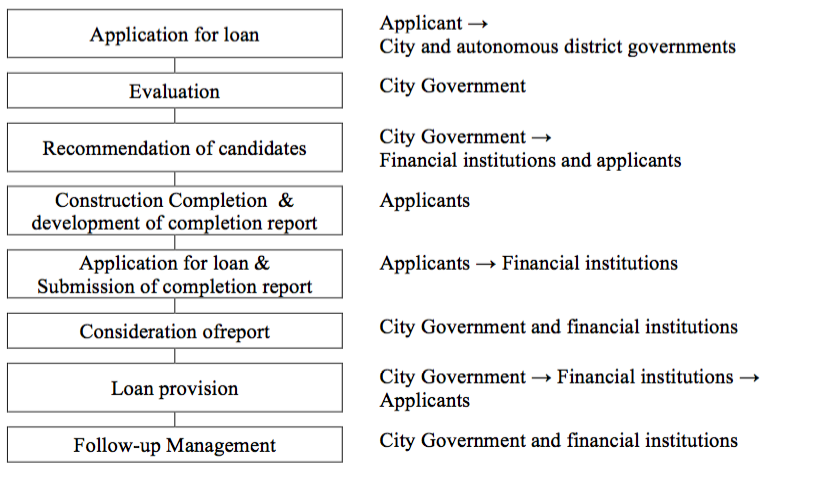
Table 7. Major Improvements in BRP
| Time | Improvement | Details |
| 2008.3 | Loan support plan established | Interest rate of 3.0% |
| 2012.2 | Interest rate discounted Targets extended |
3.0% → 2.5% Buildings → Buildings and detached houses (including apartments as of July, 2012) |
| 2012.9 | Targets extended | Private sector → Private and public sectors |
| 2013.1 | Interest rate discounted | 2.5% → 2.0% |
| 2013.8 | Targets extended | Building owners (including ESCOs) → BRP implementers (building owners, tenants, etc.) |
| 2014.1 | Interest rate discounted | 2.0% → 1.75% |
| 2014.4 | Support cap increased | Up 80% of project expenses → Up to 100% |
| 2015.10 | Improve application process for housing including additional application items | Addition of energy diagnosis cost, criteria establishment for insulation Inclusion of construction details in the project plan |
| 2016.2 | Interest rate discounted Support cap increased |
1.75% → 1.45% For housing, up to KRW 10 million → KRW 15 million |
(Source: Seoul Metropolitan Government (2016), 2016 BRP Loan Support Plan)
Technical details
The BRP is a project to improve energy efficiency focused on energy saving and production to reduce the energy loss and inefficiency factors of buildings for the construction, mechanical, electric, and other sectors.
Figure 3. Energy saving facilities of BRP
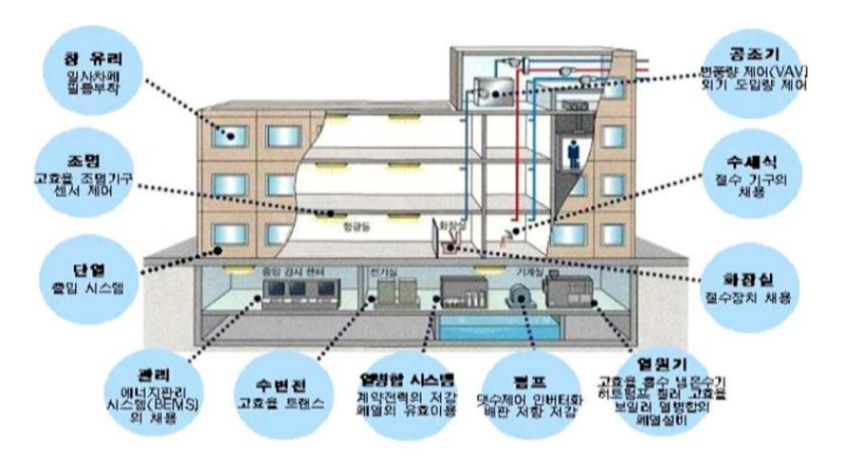
(Source: Press release of Seoul City Government “Seoul Provides Special BRP Loan to 23 Large Buildings)
1) Construction sector
It is applicable to interior and exterior wall insulation, insulated windows and doors (with an energy efficiency rating 3 or higher), and window pane film (high efficiency certified products). The criteria for new building insulation and for heat transmission coefficient of the energy saving design will be applied to newly installed insulation after the removal of existing ones. Additional insulation can be either interior and exterior insulation, providing it has a heat transmission coefficient of 1.333W/㎡K (heat conductivity class B +thickness of 30㎜) or more and 0.8W/㎡K (heat conductivity class B +thickness of 50㎜) or more, respectively.
2) Mechanical sector
To improve the efficiency of in heating and cooling, it is recommended to replace boilers, cold and hot water dispensers, and freezers with higher-efficiency units; to use city gas as fuel; and to opt for district heating wherever possible. The waste heat recovery equipment is supported through heat exchangers and heat pumps. Installed self-cogeneration systems are designed to improve energy production and consumption efficiency, building automation controllers, and the building energy management system.
3) Electrical sector
This concerns the installation of high-efficiency LED lighting and lighting efficiency improvement. More than 50% of the entire lighting will be replaced with lighting project certified with KS or with high efficiency but only with certified lighting with high efficiency ones for public facilities. Installing energy-saving air-conditioning systems (high-efficiency inverters, blowers, and motors), power substations (high efficiency transformers), and excellent stand-by power saving products (certified by Korea Energy Agency) will also aid this process. The installation of 60% or more of intelligent consents for auto stand-by power interruption is planned
4) Others
When applying for energy production facilities to install new renewable energy units (hydrogen fuel cell, geothermal, solar power) in housing and buildings, it is applicable if 50% or more of the project expenses will be spent for the retrofitting. Solar power generation providers will be distributed with loans based on special support plans.
Table 8. Applications of BRP
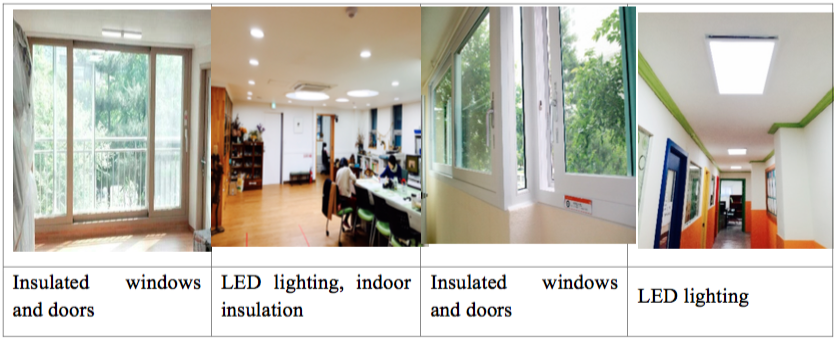
Policy effects
The BRP contributed to the growth of Seoul as a green city by contributing to the improvement of the energy efficiency of existing buildings that were consuming large proportion of the total energy in Seoul. The BRP was initiated in 2008 focusing on public agencies and extended to private buildings, including universities and hospitals, and later housing, in 2012.


Figure 8. Annual performance of BRP
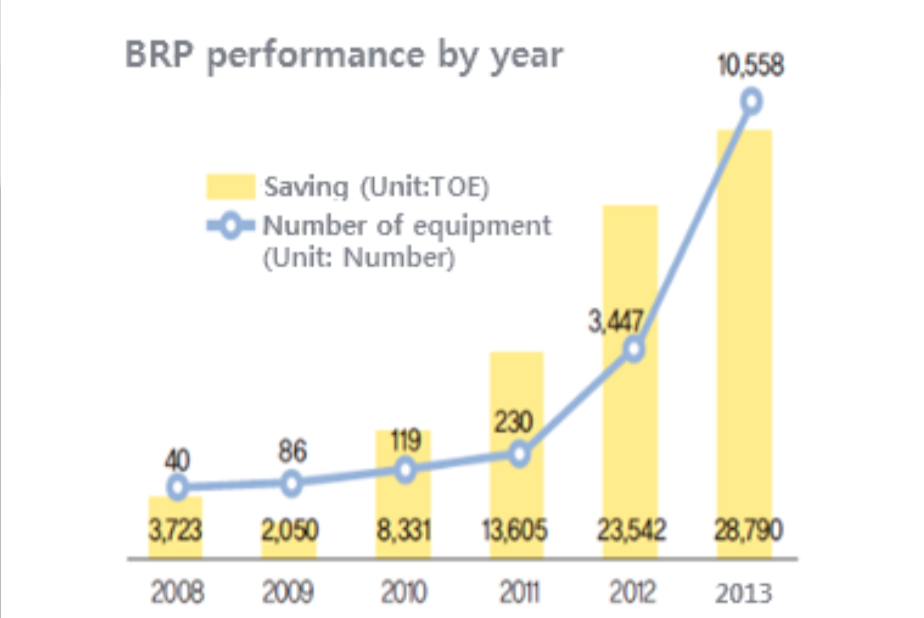
(Source: Soul Policy Office: BRP: Essential Program for Environment Protection and Economics)
Thus, the number of BRP-engaged buildings and housing increased rapidly (see Fig. 8), and therefore, the energy saving of phase 1 of the One Less Nuclear Power Plant Initiative from 2012 to 2014 reached 187,000 TOE of energy. This is about 9% of 2,040,000 TOE, which is the entire energy saving of phase One Less Nuclear Power Plant Initiative, and demonstrates that the BRP loan support considerably contributed to the improvement in the energy efficiency of buildings.

Figure 9. Performance of One Less Nuclear Power Plant by sector (Unit:1,000TOE)
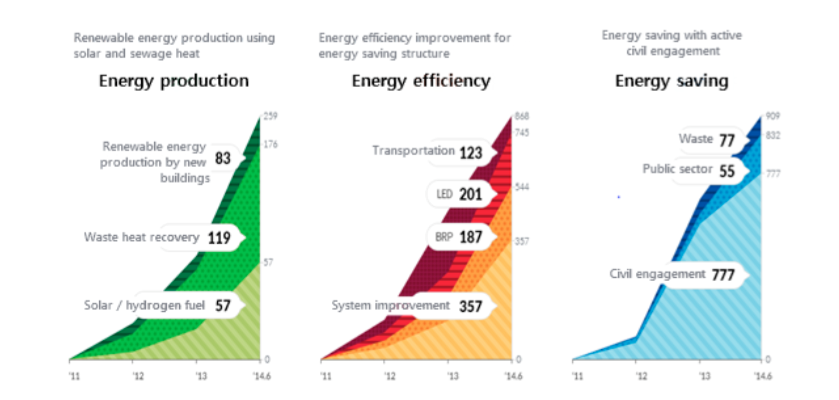
(Source: http://energy.seoul.go.kr/seoul/energy/accomp.jsp)
The BRP also signed MOUs with private businesses and groups to reduce project costs by inviting more private businesses. For example, it signed business agreements with LG House Co., Ltd. and Eagon Corporation to supply insulated windows and doors at discounted prices. In addition, it achieved very high satisfaction rates among citizens by assuring quality and follow-ups of the supplied products.
As discussed above, the BRP created environmental effects as well as considerable economic savings. Through the BRP, the Seoul Digital Industry Complex replaced its buildings’ heating and cooling systems and thus saved about 83% of its annual power consumption – a figure that amounts to about KRW 100 million of heating and cooling costs. As such, the BRP is developing the foundation forgreen growth of Seoul by creating economic effects of saving energy cost for participants, as well as environmental effects of saving energy consumption and thus reducing greenhouse gas emission.
Miliore, Dongdaemun (2008, retail facility) ◈ Energy saving of 73% (704TOE/year), project cost of KRW 900 million (loan support of KRW 500 million) ⇒ Installation of 4,522 units of high-efficiency LED lighting (power saving of 3,275MWh) |
||
KLAPP, Yangjaedong (2009, office building) ⇒ Improved insulation, windows and doors, heating and cooling, and installation of LED lighting, solar power panel, and midnight electricity equipment |
||
Hotel Plaza Seoul (2010, accommodations facility) ◈ Energy saving of 14% (378TOE/year), project cost of KRW 5.1 billion (loan support of KRW 2 billion) ⇒ installation of highly-efficient appliances including building insulation, LED lighting, building automation controllers, waste heat recovery system, and solar power |
||
Northeast building of S tower (2011, office building) ◈ Energy saving of 22% (13TOE/year), project cost of KRW 260 million (loan support of KRW 100 million) ⇒ Building insulation, windows and doors improvement, and LED replacement for existing lighting (53 EA) |
In 2013, Seoul was chosen as the Best City oSolving Environmental Issues and thus awarded with a Government Leadership Award by the World Green Action Building Council for such successful implementation of BRP.
Challenges & Solutions
Seoul considerably saved energy and reduced greenhouse gas emissions by improving the energy efficiency of existing buildings through the BRP. However, the result has been achieved by continuously improving policies and complementing the system in the process. The biggest challenges for SMG to impelement BRP include a lack of interest in retrofitting (because of economic recession) and conflicting interests between building owners and tenants on the energy efficiency facilities. Here are the policy improvements made so far and future improvements and challenges.
1) Provision of low-interest loans and cap adjustments to promote the project
Seoul has reduced the interest rates of loans to address passive investment in building facility improvements and the disconnection between energy consumption audit and facility improvements because of economic recession. The BRP was initiated in 2008 at an interest rate of 3.0% and has gradually reduced this to 1.45% as of 2016 – a number considerably lower than the commercial rate. Moreover, Seoul has continuously increased the support caps to encourage participation. The year 2014 observed a BRP support cap increase from 80% to 100% and 2016 the limits of loan support for housing from KRW 10 million to KRW 15 million to reduce the actual payment of beneficiaries. However, it is said that the barrier is still high and conditions are rather strict for taking out loans, thus, a further rearrangement of the consulting and data management system is required.
2) Reinforcement of BRP through energy consulting
To effectively improve energy efficiency in housing and buildings from phase 2 of the One Less Nuclear Power Plant, Seoul will provide customized energy audit service in consideration of the energy efficiency levels of housing and buildings. It is planned for energy consultants, energy planners, and energy audit specialists to inspect and evaluate the state of energy consumption and then advise saving plans for housing, stores of small and medium commercial buildings, welfare facilities and educational institutions for free.
3) Solutions for conflicting interests between building owners and tenants
There still remain conflicts of interest regarding energy saving facilities between building owners and tenants. Building owners do not have any incentive because they do not pay energy bills whereas tenants would have such motivation to save energy. However, a tenant rents a building for a certain period and is therefore likely to be reluctant to make upfront investments in energy saving facilities. Seoul initially targeted building owners for the BRT loan but then included tenants from 2014 in consideration of the conflicting interests between the two parties. Still, the tenants have uncertainty over their futures and need consent from building owners to install such energy saving facilities; it thus remains difficult for them to take out loans and implement the project. In order to expand the BRP, it will therefore be necessary to consider the physical condition and rental conditions of buildings for loans and support so as to reduce the burden on tenants while also offering incentives to building owners who do not directly use their buildings.